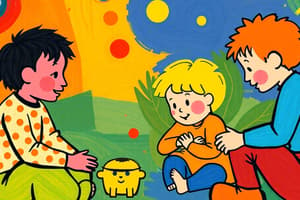Podcast
Questions and Answers
What type of play involves the repetition of behavior when new skills are being learned?
What type of play involves the repetition of behavior when new skills are being learned?
- Sensorimotor play (correct)
- Constructive play
- Social play
- Pretense play
In which type of play does a child transform the physical environment into a symbol?
In which type of play does a child transform the physical environment into a symbol?
- Games
- Social play
- Practice play
- Pretense/symbolic play (correct)
When a child treats a table as if it were a car during play, it is an example of which type of play?
When a child treats a table as if it were a car during play, it is an example of which type of play?
- Social play
- Pretense/symbolic play (correct)
- Games
- Sensorimotor play
Which type of play involves interaction with peers and sees a significant increase during the preschool years?
Which type of play involves interaction with peers and sees a significant increase during the preschool years?
What type of play combines sensorimotor/practice play with symbolic representation?
What type of play combines sensorimotor/practice play with symbolic representation?
What are activities that children engage in for pleasure and have rules?
What are activities that children engage in for pleasure and have rules?
What term is used to describe the amount of time individuals spend with television, computers, video games, and smartphones?
What term is used to describe the amount of time individuals spend with television, computers, video games, and smartphones?
Television's influence on children's development can be positive by presenting which of the following?
Television's influence on children's development can be positive by presenting which of the following?
Which of the following is a concern related to children's exposure to violence and aggression on television?
Which of the following is a concern related to children's exposure to violence and aggression on television?
What type of play involves simple rules of reciprocity and turn-taking?
What type of play involves simple rules of reciprocity and turn-taking?
How do preschool children typically engage in social games involving simple rules of reciprocity and turn-taking?
How do preschool children typically engage in social games involving simple rules of reciprocity and turn-taking?
Which of the following best describes the term 'screen time'?
Which of the following best describes the term 'screen time'?
What influences children's safety according to the text?
What influences children's safety according to the text?
Children exposed to tobacco smoke in the home are more likely to develop which symptoms according to the text?
Children exposed to tobacco smoke in the home are more likely to develop which symptoms according to the text?
What is Vygotsky's concept of the Zone of Proximal Development (ZPD)?
What is Vygotsky's concept of the Zone of Proximal Development (ZPD)?
What does Vygotsky's Theory of Scaffolding involve?
What does Vygotsky's Theory of Scaffolding involve?
How does Vygotsky believe children's cognitive development is influenced?
How does Vygotsky believe children's cognitive development is influenced?
What role does a more-skilled person play in Vygotsky's concept of Zone of Proximal Development?
What role does a more-skilled person play in Vygotsky's concept of Zone of Proximal Development?
Flashcards are hidden until you start studying
Study Notes
Types of Play
- Sensorimotor play involves exercising sensorimotor schemes to derive pleasure.
- Practice play involves the repetition of behavior to learn new skills or master physical or mental coordination.
- Pretense/symbolic play transforms the physical environment into a symbol, such as a child treating a table as a car.
- Social play involves interaction with peers and increases dramatically during preschool years.
- Constructive play combines sensorimotor/practice play with symbolic representation, resulting in the creation of a product or solution.
- Games are activities with rules, often involving competition, and can include social games with simple rules of reciprocity and turn taking.
Media and Screen Time
- Screen time describes the amount of time spent with television, DVDs, computers, video games, and hand-held electronic devices.
- Television can have a negative influence on children's development by exposing them to violence and aggression.
- Television can also have a positive influence on children's development by presenting educational programs, providing information, and displaying models of prosocial behavior.
Children's Safety
- Children's safety is influenced by their own skills and safety behaviors, as well as aspects of their family, school, peers, and community.
- Exposure to environmental tobacco smoke in the home can increase the risk of wheezing symptoms and asthma in children.
Cognitive Changes
- Piaget's pre-operational stage describes a stage of cognitive development.
- Vygotsky's theory emphasizes the role of social influences, especially instruction, in children's cognitive development.
- The zone of proximal development (ZPD) is the range of tasks that are too difficult for a child to master alone but can be learned with guidance and assistance.
- Scaffolding involves adjusting the level of support to fit a child's current performance, with more guidance provided when the child is learning a new task.
Studying That Suits You
Use AI to generate personalized quizzes and flashcards to suit your learning preferences.




